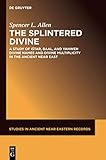The Splintered Divine : a Study of Istar, Baal, and Yahweh Divine Names and Divine Multiplicity in the Ancient Near East.
Material type: TextSeries: Studies in ancient Near Eastern records ; v. 5.Publication details: Berlin/Boston : De Gruyter, 2015.Description: 1 online resource (480 pages)Content type:
TextSeries: Studies in ancient Near Eastern records ; v. 5.Publication details: Berlin/Boston : De Gruyter, 2015.Description: 1 online resource (480 pages)Content type: - 9781614512363
- 1614512361
- 9781501500220
- 1501500228
- Ishtar (Assyro-Babylonian deity)
- Baal (Canaanite deity)
- Ishtar (Assyro-Babylonian deity)
- Baal (Canaanite deity)
- God -- Name -- Comparative studies
- God (Judaism) -- Name
- Dieu -- Nom -- Études comparatives
- Dieu (Judaïsme) -- Nom
- BODY, MIND & SPIRIT -- Gaia & Earth Energies
- RELIGION -- Christianity -- General
- RELIGION -- Theology
- God (Judaism) -- Name
- God -- Name
- Ancient Near Eastern deities
- Divine epithets
- 202.1109394
- BL473 .A45 2015
- online - EBSCO
| Item type | Current library | Call number | URL | Status | Notes | Barcode | |
|---|---|---|---|---|---|---|---|
 eBook
eBook
|
Biblioteca "Angelicum" Pont. Univ. S.Tommaso d'Aquino Nuvola online | online - EBSCO (Browse shelf(Opens below)) | Online access | Not for loan (Accesso limitato) | Accesso per gli utenti autorizzati / Access for authorized users | (ebsco)984204 |
Print version record.
0 Introduction; 0.1 Ištar-of-Nineveh and Ištar-of-Arbela; 0.2 Divine Names and Divine Multiplicity; 0.3 Outline and Method; 1 Considering Multiplicity and Defining Deity; 1.1 An Early History of Identifying and Equating Divine Names; 1.2 Toward Minimizing Multiplicity; 1.3 Toward Maximizing Multiplicity; 1.4 Agency, Names, Offerings, and Rituals; 1.5 Conclusions; Excursus: "Syncretism"; 2 Comparative Insights; 2.1 The Multiple Manifestations of the Madonna; 2.2 Hittite Multiplicity; 2.3 Conclusions.
3 The Divine Hierarchy and Embedded God Lists (EGLs)3.1 Moving Away from Lexical God Lists; 3.2 The Last Are Least; 3.3 Building Composite God Lists; 3.4 Witness-List Traditions; 3.5 Personal and Royal Correspondence; 3.6 Cultic Texts and EGLs; 3.7 Implications for the Present Study; 4 The Ištar Goddesses of Neo-Assyria; 4.1 The Ištar Goddesses by Several Other Names and Titles; 4.2 Theological Speculations about Ištar Goddesses; 4.3 The Goddess at Nineveh; 4.4 The Goddess at Arbela; 4.5 Who is Mullissu, and when is she Mullissu?; 4.6 Assyrian-Ištar; 4.8 Conclusions.
5 Geographic Epithets in the West5.1 The Baal Deities of Ugarit; 5.2 Baal-of-Ugarit and the other Baal Deities at Ugarit; 5.3 Baal: Epithet or Name?; 5.4 The Baal Deities of the First Millennium; 5.5 Why is a Baal Deity's Geography Important?; 5.6 First-millennium Goddesses in Northwest Semitic Texts; 5.7 Conclusions; 6 A Kuntillet 'Ajrud Awakening; 6.1 "Hear, O Israel, Yahweh//our-God"; 6.2 The Geographic Origin of Yahweh: Teman; 6.3 Yahweh and the Kingdom of Israel: Samaria; 6.4 Yahweh and the Kingdom of Judah: Zion and the Hosts; 6.5 Yahweh and the bet-Locative; 6.6 Conclusions.
7 Conclusions7.1 Summary; 7.2 Implications; Bibliography; Maps; Appendix: Tables 1.1-7.1; Indices; Primary Texts Index; General Index.
"This book investigates the issue of the singularity versus the multiplicity of ancient Near Eastern deities who are known by a common first name but differentiated by their last names, or geographic epithets. It focuses primarily on the Ishtar divine names in Mesopotamia, Baal names in the Levant, and Yahweh names in Israel"-- Provided by publisher
Includes bibliographical references (pages 321-341) and indexes.
English.


